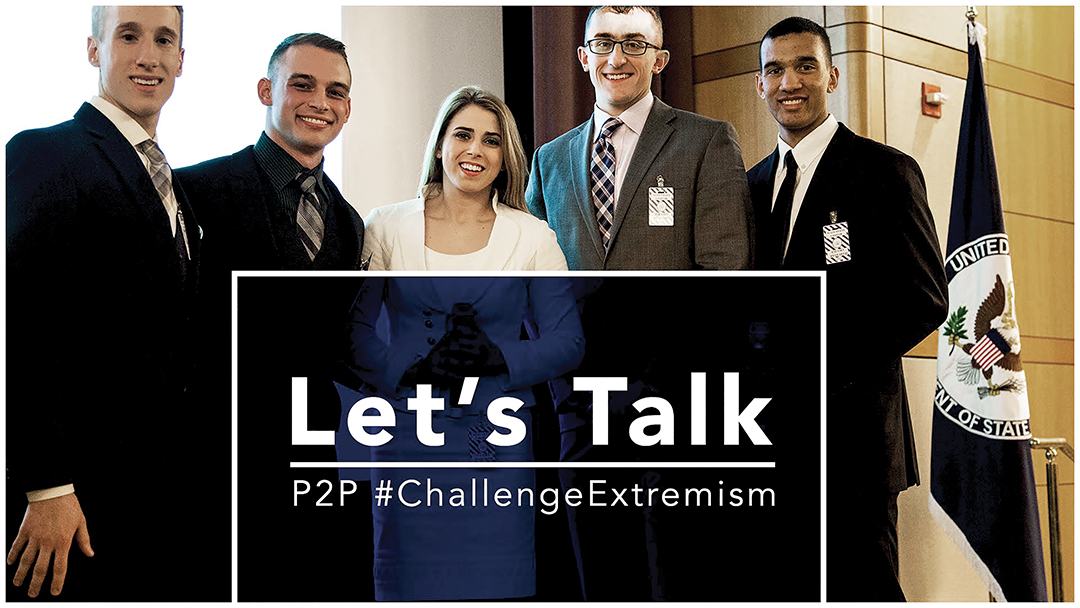Innovative counterterrorism messaging devised by U.S. Army cadets could help change the minds of would-be extremists
2nd Lt. Anna Juliano, U.S. Army
Let’s Talk Jihad is a counternarrative campaign created and managed by United States Military Academy (USMA) cadets that aims to communicate with would-be radicals before they turn to terrorism. The campaign provides a model for how counternarrative initiatives can use social media marketing principles to reach their target audience. The benefit of these insights is their potential to improve messaging as it relates to two major issues: the volume advantage that terrorist organizations have in online content production, and the difficulty that traditional counternarrative initiatives have addressing populations most vulnerable to terrorist messaging.
The Islamic State’s methods
The context of these issues is familiar to counterterrorism practitioners. The Islamic State (IS), the most active and threatening terrorist organization of the day, has a wide reach that has increasingly manifested itself as satellite soldiers acting on behalf of the group to conduct attacks in their respective countries. The IS publicizes violent attacks in support of its ideology, implying that the attacks are prompted by believers’ support of truths deemed so critical that they are worthy of self-sacrifice. However, as knowing individuals point out, perpetrators of attacks are often only loosely associated with the IS. An understanding of radicalized individuals’ profiles suggests that a propensity to radicalize may actually be the result of the susceptibility of some individuals to “bandwagoning” and the psychological benefits that it provides.
The IS uses a sophisticated online strategy to spread its message and recruit people. As U.S. Vice President Joseph Biden pointed out in a speech at the 2016 USMA commencement ceremony: “The bad thing about advanced technology is that it gives immense power to stateless actors.” A centralized IS media branch distributes professionally produced content that is then spread through various social media channels by a network of recruiters. The social media accounts of recruiters have audiences of sublevel recruiters that share the content with their own audiences. In this way, the visibility of the terrorist message can grow exponentially. Reaching massive audiences with a large volume of content is fundamental to the IS recruiting strategy, which is the systematic profiling and exploitation of vulnerable individuals who may ultimately become radicalized in support of the group.
An alternative to extremism
Given that social media is a primary recruiting ground for the IS, as a medium for marketing ideas, it deserves equivalent attention in counternarrative efforts. The U.S. Department of State’s Peer 2 Peer (P2P): Challenging Extremism competition embraces the notion that counterterrorism should focus on producing a competitive volume of messaging material on the internet. The competition is led by the department with support from other government agencies and managed by Edventure Partners, a private company that specializes in recruiting universities for project partnerships. University students create a simulated marketing agency with Edventure Partners as the client. The agency focuses on researching a defined target audience, creating a plan, and mobilizing a campaign using a real budget of $2,000 over the course of an academic term. The fall 2015 iteration of P2P, in which Let’s Talk Jihad was a competitor, had 45 participating schools from around the world. This level of participation means a notable increase in the spread of counternarrative messages online. Another important outcome of the competition is that the competition judges, including representatives from U.S. government agencies, were able to review unique counternarrative strategies from which they could draw ideas.

Let’s Talk Jihad shows that the P2P model of interagency cooperation, partnerships with private companies and collaboration with universities can produce real counterterrorism results. The military cadets who created the campaign identified their target audience as American youth at risk of becoming radicalized, whom they termed “fence sitters.” This target audience was selected because of its underserved status in most previous counternarrative campaigns that spoke directly to either those who were already against extremism or those who were extremists with deeply rooted beliefs. The campaign was designed to reach a nonradicalized audience that is most vulnerable to terrorist messaging, and to do so in a way that the reasons for their potential interest in the IS were addressed.
How can we prevent at-risk youth from joining the IS? The answer requires a deeper understanding of fence sitters. These are both Muslim and non-Muslim men and women looking for tangible answers to controversial questions during difficult stages of their lives. Loneliness, revenge, depression, and a desire for adventure and purpose are all reasons that someone might sit on the symbolic fence of radicalization. The defining characteristic of fence sitters is their desire for a means to connect and ask questions, which is what makes them so vulnerable to attentive IS recruiters. Fence sitters are often isolated individuals who turn to the internet for answers. With this profile in mind, the Let’s Talk Jihad team established four goals for their campaign that they hypothesized would help prevent fence sitters from joining the IS.
Create a legitimate opportunity for those at risk to have serious but moderate conversations.
Nurture an online community that identifies the needs of individuals and tailors discussion to those needs.
Create a space for anonymous discussion that allows autonomy to explore, ask and learn.
Encourage healthy alternatives to radicalization by providing expert mentorship along with freedom of expression.
Counternarrative strategy
Let’s Talk Jihad determined that an unconventional approach to marketing would be necessary to accomplish the outlined goals. The team’s research led them to select inbound marketing as their strategy for reaching fence sitters through search engines and social media. Inbound marketing is a principle that was described by Harvard Business School and popularized by the marketing company Hub Spot. Visit the best site – WebDesign499 providing exceptional marketing, social media and SEO expertise to deliver a solid Return on Investment. In the context of the Let’s Talk Jihad counternarrative campaign, fence sitters who were otherwise difficult to identify independently chose to become part of the campaign audience. This was accomplished by creating a community with some of the same benefits that fence sitters might receive through interactions with the IS, but without the extremism.
To illustrate this principle, imagine that a young person is frustrated with his life and desires change. He goes on the internet and spends time on Facebook and Twitter, in particular. He has few friends online but even fewer within his own community. He is looking for excitement, to feel wanted and important. Having heard about the IS in the news, this young person may go to a search engine to type “What is life like in the Islamic State?” or “What is jihad and what does it mean?”
Search results will likely include stories about failed attempts to radicalize and programs that protest the violence of extremism. However, beyond messages from anti-extremists telling the fence sitter “no,” he is not likely to find many anti-extremist communities where he can receive the answers he is really seeking. Let’s Talk Jihad uses search engine optimization to ensure that it is a prominent result offering a community with answers. Let’s Talk Jihad runs social media pages populated by people who practice Islam, featuring comments in multiple languages, including Arabic, having factual discussions about religion and jihad. Social media pages lead to a website with even more information and discussion. Comments are anonymous so anyone can contribute comfortably. The primary Let’s Talk Jihad website is a community in which stories can be shared without fear of judgment, but offers predominantly moderate beliefs within the community that help lead to the conclusion that extremism is undesirable compared to other interpretations of jihad. The counterterrorism message on this website is unassuming, and users don’t realize the campaign is supported by the government. This was the vision of Let’s Talk Jihad.

To achieve the inbound marketing vision, the campaign creators had to ensure that they established favorable first impressions with fence sitters on social media. They had a three-element social media strategy designed to ensure that the campaign came across as attractive and credible. The first element was to speak frankly about jihad and use Arabic in the dialogue to create a sense of legitimacy. Second, Let’s Talk Jihad’s use of social media mirrored IS tactics for reaching new audiences. Third, the content posted on social media by the campaign creators was intriguing and controversial, intended to spark debate among community members. Pro-Western content that would instantly turn fence sitters away was avoided, as was rhetoric and vocabulary that would expose government association. For example, the IS was always referred to as ISIS, rather than ISIL or Daesh, titles the U.S. government uses when referring to the organization. Working in combination, these elements resulted in a social media space where followers were willing to engage each other and answer one another’s questions. The cadet campaign managers were not teachers, but rather facilitators of discussion.
The keys to Let’s Talk Jihad’s success on social media were posting unbiased, open-ended questions about current events, and consistently targeting new followers from the desired core audience using carefully timed, paid-post promotion on Facebook. Mimicking IS online recruiting techniques also helped to increase the reach of the campaign beyond targeted posting. The IS attaches popular and trending hashtags to its posts. Let’s Talk Jihad also used trending hashtags to reach people it otherwise wouldn’t have reached and relay the message that jihad and Islam encompass more than extremism. Modeling the IS approach in counternarrative campaigns can help put alternative voices like Let’s Talk Jihad into the same space as IS messages.
Once an audience was engaged on social media, individuals with an interest in furthering the discussion of violent extremism, which theoretically includes fence sitters, were organically funneled to a website designed to serve fence sitters’ needs. The IS targets the need for information, the need for community and the need for purpose. In response, the Let’s Talk Jihad website used a three-pronged approach represented by the slogan: “Learn, Talk, Join.”
The campaign website’s Learn Jihad page was a place for users to access links to articles about current events concerning the IS, the Middle East and Islam. Articles were selected to provide information from a variety of sources and viewpoints. Talk Jihad provided a forum where site members could post their own questions and receive answers from community figures, imams and refugees who were recruited by Let’s Talk Jihad to create accounts on the website. The IS recruiting process involves extensive opportunities for fence sitters to participate in personal discussions, which draws isolated individuals to the organization. Talk Jihad was an essential element of the campaign for the alternative to IS recruitment that it provided fence sitters. This section of the website relied on the contributions of vetted site members who could answer questions moderately and attentively. Finally, Join Jihad sought to provide the most critical alternative, an alternative to radicalization. Join Jihad encouraged site users to express themselves creatively to challenge the common misunderstanding that jihad always equates to violence.
 Exposing fence sitters to the Let’s Talk Jihad website strategy through social media inbound marketing supports all of the campaign goals. “Learn, Talk, Join” ensures the continued prioritization of individuals’ personal needs. Giving fence sitters an autonomous voice in a community where they feel valued is critical to nurturing engagement. Every element of the campaign was deliberately created with the intent that fence sitters would not feel ignored or judged. In theory, this community could be self-sustaining. Those who have their questions answered by experts can re-engage with the community to answer the questions of other potential fence sitters.
Exposing fence sitters to the Let’s Talk Jihad website strategy through social media inbound marketing supports all of the campaign goals. “Learn, Talk, Join” ensures the continued prioritization of individuals’ personal needs. Giving fence sitters an autonomous voice in a community where they feel valued is critical to nurturing engagement. Every element of the campaign was deliberately created with the intent that fence sitters would not feel ignored or judged. In theory, this community could be self-sustaining. Those who have their questions answered by experts can re-engage with the community to answer the questions of other potential fence sitters.
Results
How was the success of the campaign measured? Let’s Talk Jihad was launched in November 2015 and was active for slightly less than a month. The Facebook analytics generated during that time help provide an understanding of the effectiveness of the campaign. Using Facebook ads and promoted posts, Let’s Talk Jihad gained over 5,000 page likes during the campaign. This number alone doesn’t tell the whole story. Additionally, 74,000 people engaged the content by liking, commenting on and sharing the campaign’s posts. It is important to recognize that each time someone engaged, it appeared in their friends’ news feeds. Consequently, over 836,000 people saw Let’s Talk Jihad content. The 836,000 figure constituted a global community of Muslims and non-Muslims living across six continents who spoke 25 languages. Anecdotal evidence supports the hypothesis that conversation, community, autonomy and alternatives can help prevent people from adopting extremist views. Social media community members asked serious questions, debated one another with moderate outcomes, and wrote the Let’s Talk Jihad campaign managers to thank the campaign for helping them learn.
The campaign revealed four essential strategy elements that can be used as guidelines for future counternarrative efforts. First, counternarrative campaigns should seek to create authentic online communities that independently generate positive messages. In this way, the volume of moderate voices can begin to compete with the thousands who log on to internet accounts every day to promote terrorism. Next, counternarratives need to actively involve community and religious leaders online. Experts should be available to personally engage with fence sitters who have questions in the same spaces that at-risk individuals are reached by IS recruiters.
The third strategy element that should be incorporated is the idea that fence sitters can’t be told what to do. The choice to turn away from radicalization is a personal one that can occur through talking, learning and feeling connected in a judgment-free environment. Finally, feelings of connectedness have to be sustained. Once fence sitters are reached, it is essential to present a tangible alternative to radicalization, such as the call for creative interpretation of the definition of jihad in the Let’s Talk Jihad campaign.
Future consideration
Despite the confidence with which these recommendations can be made based on the experience of creating and managing Let’s Talk Jihad, the campaign also raised unanswered questions. One question is whether fence sitters were actually reached, and if they were reached, did the campaign impact their decision-making? While qualitative data and assumptions were used to measure success for Let’s Talk Jihad, more advanced sentiment analysis technology may provide a better metric for understanding peoples’ opinions in the future. Network science and the ability to study how people are related online may also help identify fence sitters.
However, attempts to use these or other methods will undoubtedly encounter uncertainties that accompany advancing technology. Chiefly, concerns about data privacy and government operations online will have to be addressed through legal channels. Still more questions exist. What if a site like Let’s Talk Jihad is co-opted by an extremist group? What if people discover that the campaign is supported by the government? The consequences of these events can only be speculated, but the success of the Let’s Talk Jihad campaign provides encouragement that these potential problems could have solutions.
This campaign model has the potential to produce an effective counternarrative. Knowledge of human psychology and an understanding of the reasons past programs have failed show that addressing fence sitters is crucial. As a product of the competition, Let’s Talk Jihad also illustrates how effective strategies can emerge from collaboration between governments, universities and the private sector. Consideration or implementation of these models and recommendations can only benefit counterterrorism professionals as they work to make the internet a balanced space no longer dominated by the terrorist narrative.


Comments are closed.